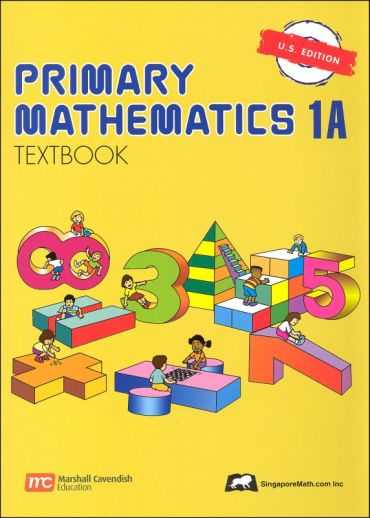We use cookies to make your experience better. To comply with the new e-Privacy directive, we need to ask for your consent to set the cookies. Learn more.
Primary Math US 1A Textbook
Textbooks present new concepts and learning tasks for students to complete with educator supervision. They include practice and review problems, and are designed to be used alongside workbooks.
Features & Components:
- Mathematical concepts are introduced in the opening pages and taught to mastery through specific learning tasks that allow for immediate assessment and consolidation.
- The Concrete Pictorial Abstract approach enables students to encounter math in a meaningful way.
- Direct correlation of the textbook to the workbook facilitates focused review and evaluation.
- The modeling method enables students to visualize and solve problems quickly and efficiently.
- New mathematical concepts are introduced through a spiral progression that builds on concepts already taught and mastered.
- Metacognition is employed as a strategy for learners to monitor their thinking processes in problem solving. Speech and thought bubbles provide guidance through the thought processes, making even the most challenging problems accessible to students.
- Color patches invite active student participation and facilitate lively discussion about concepts.
- Regular reviews in the textbook provide consolidation opportunities.
Note: Two textbooks (A and B) for each grade correspond to the two halves of the school year. Answer key not included.
Primary Math U.S. Edition uses the Singapore methodology (based on the Singapore’s Ministry of Education Syllabus) that employs a concrete-to-pictorial-to-abstract approach to teaching. Concrete illustrations are incorporated heavily in the early grades, gradually giving way to more abstract representations so that math is learned meaningfully. The program builds strong problem solving, critical thinking, and computational skills through well-chosen practice problems. Primary Math focuses on topics such as using whole numbers, fractions, and decimals, perimeter, area, volume, angles, quadrilaterals, symmetry, time, length, weight, money, graphs, and algebraic expressions. American money and U.S. measurements are included in the U.S. edition of this curriculum.
Each grade consists of two semester sets to be completed in one year. The ‘A’ textbook and workbook would be first semester, and the ‘B’ textbook and workbook would be second semester. Although the pace of the course really depends on the individual student, 2-3 pages in the text is usually enough for one day's lesson. Brief teacher instructions are provided in the textbook’s preface, but the Home Instructor Guide offers answers and more in-depth instruction and how to use optional manipulatives for the parent. Sets include text, workbook, and Home Instructor’s Guide.
We also offer supplemental Primary Math U.S. Extra Practice Books for each grade level. Optional, these helpful Extra Practice books provide additional practice problems organized by grade level topics. Convenient math manipulative kits are also available. Compared to Saxon Math, Primary Math encompasses a narrower scope. While Saxon Math covers coordinate graphing, negative numbers, square roots, and probability, these topics are omitted from Primary Math and are not covered until New Elementary Math. The smaller scope, however, allows the program to emphasize the basics. Primary Math focuses on the four arithmetic operations (using whole numbers, fractions, and decimals), perimeter, area, volume, angles, quadrilaterals, symmetry, time, length, weight, money, graphs, and algebraic expressions (introduced in 6th grade). Saxon Math moves a bit slower introducing Algebra in Math 87.
| Product Format: | Softcover Book |
|---|---|
| Grade: | 1 |
| Brand: | Marshall Cavendish |
| ISBN: | 9789810184940 |
| Length in Inches: | 10.25 |
| Width in Inches: | 7.5 |
| Height in Inches: | 0.25 |
| Weight in Pounds: | 0.45 |


It's simple and straight forward. Has great visual imagery for the math concepts.
We already use this math for homeschool
brightly colored and strong mathematical base to ensure I'm covering what my 7 year old needs while going fast enough through his curriculum to keep him interested as he is pretty precocious and…
colorful, solid and retain math curriculum.